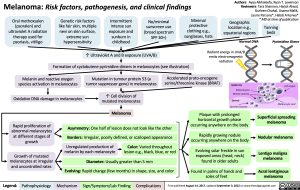Melanoma: Risk factors, pathogenesis, and clinical findings
Authors: Ayaa Alkhaleefa, Ryan T. Lewinson Reviewers: Tara Shannon, Harjot Atwal, Gurleen Chahal, Usama Malik, Laurie Parsons*, Habib A Kurwa* * MD at time of publication
Oral methoxsalen (psoralen) and ultraviolet A radiation therapy used for psoriasis, vitiligo
Genetic risk factors like fair skin, multiple nevi on skin surface, extreme sun hypersensitivity
Intermittent intense sun exposure and sunburn in childhood
No/minimal sunscreen use (broad spectrum SPF 30+)
Minimal protective clothing e.g., sunglasses, hats
Geographic location e.g., equatorial regions
Tanning beds
Pyrimidine Dimer
Normal DNA
↑ Ultraviolet A and B exposure (UVA/B)
Formation of cyclobutene pyrimidine dimers in melanocytes (see illustration)
Radiant energy in UVA/B emits electromagnetic radiation
Melanin and reactive oxygen species activation in melanocytes
Oxidative DNA damage in melanocytes
Mutation in tumour protein 53 (a tumor suppressor gene) in melanocytes
↑ Cell division of mutated melanocytes
Melanoma
Asymmetry: One half of lesion does not look like the other Borders: Irregular, poorly defined, or scalloped appearance
Accelerated proto-oncogene serine/threonine kinase (BRAF)
Rapid proliferation of abnormal melanocytes at different stages of growth
Growth of mutated melanocytes at irregular and uncontrolled rates
Unregulated production of melanin by each melanocyte
Color: Varied throughout lesion e.g., black, blue, or red
Plaque with prolonged horizontal growth phase occurring anywhere on the body
Rapidly growing nodule occurring anywhere on the body
Evolving solar freckle in sun exposed areas (head, neck) found in older adults
Found in palms of hands and soles of feet
Superficial spreading melanoma
Nodular melanoma
Lentigo maligna melanoma
Acral lentiginous melanoma
Diameter: Usually greater than 5 mm
Evolving: Rapid change (few months) in shape, size, and color
Legend:
Pathophysiology
Mechanism
Sign/Symptom/Lab Finding
Complications
First published August 14, 2017, updated September 3, 2022 on www.thecalgaryguide.com
Foundations
Systems
Other Languages
Dermatology Skin Cancer Melanoma: Pathogenesis and clinical findings melanoma-pathogenesis-and-clinical-findings

